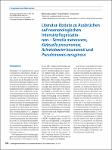Literatur-Update zu Ausbrüchen auf neonatologischen Intensivpflegestationen – Serratia marcescens, Klebsiella pneumoniae, Acinetobacter baumannii und Pseudomonas aeruginosa
Kraus-Haas, Martina
Mielke, Martin
Simon, Arne
Gehäufte Nachweise von fakultativ pathogenen Bakterien in klinischen Materialien (abgenommen bei Infektionsverdacht) und in Abstrichen zur mikrobiologischen Surveillance müssen in neonatologischen Intensivpflegestationen (NICUs) aufgrund der besonderen Patientencharakteristika, des klinischen Bildes und des Erregerspektrums separat von Ausbrüchen in anderen Intensivstationen betrachtet werden. Zur Verbesserung des Ausbruchsmanagements und der Prävention ist es sinnvoll, die aktuelle Literatur zu Ausbrüchen in NICUs regelmäßig zu analysieren. Der hier vorgelegte Beitrag aktualisiert und erweitert eine 2007 publizierte Übersicht von Gastmeier et al. und analysiert NICU-Ausbrüche durch Serratia marcescens, Klebsiella pneumoniae, Acinetobacter baumannii und Pseudomonas aeruginosa. In terms of the unique risk profile, the clinical course of nosocomial infections, and the most prevalent bacterial pathogens, literature on outbreaks of potentially pathogenic bacteria on neonatal intensive care units (NICUs) needs to be analyzed separately from reports derived from other intensive care units. With the purpose of updating important information for those involved in outbreak management and fostering preventive efforts, this article summarizes the results of a systematic literature analysis, referring to an earlier publication by Gastmeier et al. This review focuses on NICU outbreaks caused by Serratia marcescens, Klebsiella pneumoniae, Acinetobacter baumannii, and Pseudomonas aeruginosa.
No license information

